|
|
|
Sort Order |
|
|
|
Items / Page
|
|
|
|
|
|
|
| Srl | Item |
| 1 |
ID:
123068
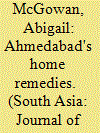

|
|
|
|
|
| Publication |
2013.
|
| Summary/Abstract |
Long known as innovative in modernist architecture, mid century Ahmedabad was also pioneering in another area of built form: housing. Starting in the 1920s when Indians seized control of urban politics, Ahmedabadis launched a number of bold new initiatives to improve housing in the city, involving a striking range of actors-labour activists, middle-class reformers, mill owners, and municipal leaders. Largely ignored under earlier British leadership, housing became a key way for Ahmedabadis to lay claim to a new, more inclusive vision of the city. Although housing continued to play a prominent role in politics after Independence, the 1950s actually marked a retreat from that earlier inclusive vision, ultimately enshrining the class and community segregation that marks Ahmedabad today.
|
|
|
|
|
|
|
|
|
|
|
|
|
|
|
|
| 2 |
ID:
134415
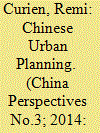

|
|
|
|
|
| Summary/Abstract |
How should the considerable discrepancy between the concepts of sustainable urban development proclaimed by the Chinese authorities and the reality on the ground be understood? This article examines the urban planning procedures that currently hold sway in China. The building of new cities is based upon a generic method of hyper-productivist and functionalist planning, reflected as a pyramid structure that extends over the whole country and is embodied by urban zoning on a vast scale. This procedure, which has been in force for nearly 30 years, is not at present one that is called into question by Chinese decision-makers, and does not take environmental principles seriously into account. Conversely, all of the reasoning upon which urban development is based remains very far removed from environmental considerations. China is continuing down the road of accelerated development behind the wheel of a growing hyper-functionalist urban machine.
|
|
|
|
|
|
|
|
|
|
|
|
|
|
|
|
| 3 |
ID:
179571
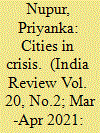

|
|
|
|
|
| Summary/Abstract |
The Covid-19 pandemic and the subsequent migrant crisis has exposed and magnified the cracks in the politico-economic arrangements of our cities. Going beyond the pandemic, however, the article argues that the crisis is rooted in the manner in which our cities have been imagined, planned, and developed under the modernist paradigm and further guided by the neoliberal framework. The problems that have surfaced today have been always present but been brushed aside or given symptomatic treatment in the governance and policy sphere. Engaging with the planning and its interrelated dynamics in Delhi from a social justice perspective, the article explores the imagination of the city as formulated over the years through urban planning, how it impacts the integration of the migrant labor in the city and how the state capacity is central to these questions.
|
|
|
|
|
|
|
|
|
|
|
|
|
|
|
|
| 4 |
ID:
180870
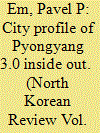

|
|
|
| 5 |
ID:
137721
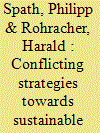

|
|
|
|
|
| Summary/Abstract |
Approaches to ‘sustainability transitions’ stress the possibility of aligning actors around a shared vision of the future, e.g. at the scale of a city. Empirical accounts reveal how difficult such coordination often is due to contradictory views involved. How can we better understand related processes of searching and negotiation? What does this mean for the organization of decision making processes regarding long-term infrastructural change? We analyze a conflict which erupted in Freiburg, Germany when two strategies of reducing environmental impacts of space heating were to be applied in the Vauban ‘model district’: A) Efficient co-generation of heat and power (CHP) combined with district heating systems (DHS), and B) Reducing heat demand by low-energy designs and ambitious energy standards (‘passive house standard’). In order to understand the politics of infrastructure development, we unravel 1) enabling factors and driving forces of the conflict, 2) normative content of opposing viewpoints, 3) resources tapped into for settling the disagreement, and 4) the institutional setup of such decision making about energy policy priorities in the municipality. We reflect on implications of such a perspective on how policies and how governance arrangements should ideally be shaped and take a brief outlook on further research needed.
|
|
|
|
|
|
|
|
|
|
|
|
|
|
|
|
| 6 |
ID:
187176
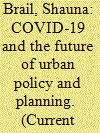

|
|
|
|
|
| Summary/Abstract |
The pandemic has brought major disruptions to cities, particularly in patterns of work and transportation. Predictions of the death of downtowns may have been premature, but urban planners are rethinking the traditional central business district, transit systems, public spaces, and other key features of city life as many office workers remain slow to return to old routines. As they face the prospect of lower tax revenues, governments will have a major role to play in helping cities adapt and stay vibrant.
|
|
|
|
|
|
|
|
|
|
|
|
|
|
|
|
| 7 |
ID:
152163
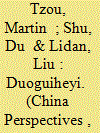

|
|
|
|
|
| Summary/Abstract |
Chinese urban planning has recently begun an institutional revolution that seeks to integrate plans drawn up by several ministries. Aimed at giving more coherence to public action, the process of integration, already technically complex, is confronted with a power struggle between administrations, making duoguiheyi difficult to implement.
|
|
|
|
|
|
|
|
|
|
|
|
|
|
|
|
| 8 |
ID:
092789


|
|
|
|
|
| Publication |
2009.
|
| Summary/Abstract |
District heating is a technology for distributing centrally produced heat for space heating and sanitary hot-water generation for residential and commercial uses. The objectives are to identify which subsystems and components of a district heating grid are the main contributors to the overall impact of the infrastructure; and provide environmentally oriented design strategies for the future eco-redesign of these kinds of infrastructures. This paper performs a life-cycle assessment (LCA) to determine the environmental impacts of a district heating infrastructure in an urban neighbourhood context. The analysis covers seven subsystems (power plant, main grid, auxiliary components of the main grid, trench works, service pipes, buildings and dwellings) and twelve standard components. The results for the subsystems show that the sources of impact are not particularly located in the main grid (less than 7.1% contribution in all impact categories), which is the focus of attention in the literature, but in the power plants and dwelling components. These two subsystems together contribute from 40% to 92% to the overall impact depending on the impact categories. Concerning the components, only a reduced number are responsible for the majority of the environmental impact. This facilitates identifying effective strategies for the redesign of the infrastructure.
|
|
|
|
|
|
|
|
|
|
|
|
|
|
|
|
| 9 |
ID:
179111
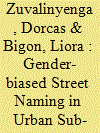

|
|
|
|
|
| Summary/Abstract |
This article explores the present-day problematic of gender-biased street names as prevalent in sub-Saharan Africa’s cityscapes. That is, the abundance of masculine street names as opposed to feminine ones in the urban environments of this region. The article first provides a comparative view on the scope of this toponymic phenomenon in other geographic regions with relation to sub-Saharan Africa. It also identifies few decisive factors in the creation of the gender-biased urban landscapes in sub-Saharan Africa. These factors consist of: recent tendencies in critical toponymy studies; colonial and post-colonial cultures of governmentality; and inadequate urban planning legislation and vision as pertained by post-colonial states. This toponymic problematic is then exemplified in a site-specific analysis of the city of Bindura in north-eastern Zimbabwe. The article concludes with recommendations for designing a more socially inclusive urban management policy in the region, pointing to future research directions of this under-studied phenomenon in critical place-name studies.
|
|
|
|
|
|
|
|
|
|
|
|
|
|
|
|
| 10 |
ID:
182408
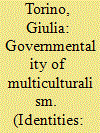

|
|
|
|
|
| Summary/Abstract |
Using a combination of discourse analysis in policy documents and ethnographic fieldwork, this paper interrogates the relation between Colombia’s pluri-ethnic turn and the governance of cosmopolitan multiculturalism in the capital city, Bogotá. Focussing on the city’s most important development framework, the POT (Plan de Ordenamiento Territorial), it reveals the controversy that exists between the multicultural discourses of the public administration (rooted in claims of ethno-racial equality and Affirmative Action) and their operationalisation in urban planning. In doing so, the paper conceptualises the urban governmentality of multiculturalism as the apparatus through which the municipality has been removing anti-racism and a race-informed understanding of socio-spatial dynamics from Bogotá’s official agenda of ‘cosmopolitan multiculturalism’. By drawing on Latin American racial theories of mestizaje, the paper thus extends the understanding of how neoliberal urban governance, while celebrating cultural diversity, denies the racialisation of space in the city.
|
|
|
|
|
|
|
|
|
|
|
|
|
|
|
|
| 11 |
ID:
178306
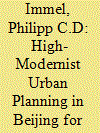

|
|
|
|
|
| Summary/Abstract |
This article analyses the implementation process of Beijing’s current urban master plan using the background of modernisation theory. The line of thought behind the new urban master plan follows a high-modernist ideology embedded in an environment of reflexive modernity. Intermediate goals of the urban master plan are to tighten population control and increase social legibility of the city, providing an additional explanation for state-led urbanisation besides economic reasons. Urban planning is thus used as a social control mechanism and has emerged as a new means to maintain social distinction, creating new forms of exclusion. It can be observed that disruptive Mao era style pushes are still being employed in the policy cycle even today. This becomes evident from the implementation style of urban planning, where campaign-style and regularised implementation methods are complementing each other. This is corroborated through documentary analysis, interviews, and fieldwork conducted by the author.
|
|
|
|
|
|
|
|
|
|
|
|
|
|
|
|
| 12 |
ID:
186075
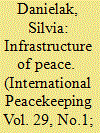

|
|
|
|
|
| Summary/Abstract |
In the context of the current UN-led stabilization efforts in Mali, the United Nations peacekeeping mission undertakes significant investments in small-scale infrastructure development. The projects not only point to the spatial imprint of peacebuilding on the post-war landscape, but to the imagined performative power of infrastructure. Based on a survey of policy document and official communications, I investigate UN peacekeepers’ narratives of reconstruction, development, and peace promoted through this infrastructure building, and essentially, their role as urban planners in the context of the international military intervention. The account of peacebuilding through infrastructure projects and development resonates with the liberal peace paradigm but also problematizes the practice of civil–military intervention and its focus on infrastructure as device to achieving peace goals.
|
|
|
|
|
|
|
|
|
|
|
|
|
|
|
|
| 13 |
ID:
152166
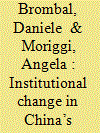

|
|
|
|
|
| Summary/Abstract |
Over the past decade, the concept of sustainable development has gained increasing importance within China’s urban development. Urban(ising) China not only catalyses many of the country’ sustainability issues, but also constitutes the locus where novel institutional arrangements for sustainable development are tested and implemented. This paper explores new paradigms of integrated territorial management unfolding in areas where concerns of water pollution intersect with objectives of urban renewal. The analysis focuses on the case of the Lihu Lake basin, located in the city of Wuxi (Jiangsu Province), considered by many observers to be at the forefront in China’s quest for sustainable urban development. In Lihu the integration of environmental management with urban planning has led to the creation of a new organisational field, revolving around the issue of sustainable development of urban areas, with distinctive regulatory, normative, and cognitive aspects. While epitomising a case of integrated territorial management, the experience of Lihu Lake basin highlights the challenge of fostering inclusive social development in urban areas.
|
|
|
|
|
|
|
|
|
|
|
|
|
|
|
|
| 14 |
ID:
125286
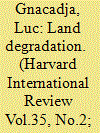

|
|
|
|
|
| Publication |
2013.
|
| Summary/Abstract |
Last year, the world met its Millennium Development Goal of halving the number of people without access to safe drinking water, five years ahead the 2015 deadline. However, 11 percent of the world' population, or 783 million people, still live without access to safe drinking water, 40 percent of them in sub-Saharan Africa.
|
|
|
|
|
|
|
|
|
|
|
|
|
|
|
|
| 15 |
ID:
124891
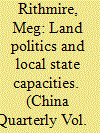

|
|
|
|
|
| Publication |
2013.
|
| Summary/Abstract |
Despite common national institutions and incentives to remake urban landscapes to anchor growth, generate land-lease revenues and display a capacious administration, Chinese urban governments exhibit varying levels of control over land. This article uses a paired comparison of Dalian and Harbin in China's north-east to link differences in local political economies to land politics. Dalian, benefiting from early access to foreign capital, consolidated its control over urban territory through the designation of a development zone, which realigned local economic interests and introduced dual pressures for enterprises to restructure and relocate. Harbin, facing capital shortages, distributed urban territory to assuage the losers of reform and promote economic growth. The findings suggest that 1) growth strategies, and the territorial politics they produce, are products of the post-Mao urban hierarchy rather than of socialist legacies, and 2), perhaps surprisingly, local governments exercise the greatest control over urban land in cities that adopted market reforms earliest.
|
|
|
|
|
|
|
|
|
|
|
|
|
|
|
|
| 16 |
ID:
099430


|
|
|
|
|
| Publication |
Washington, DC, World Bank, 2010.
|
| Description |
xxii, 106p.
|
| Standard Number |
9780821383148
|
|
|
|
|
|
|
|
|
|
|
|
Copies: C:1/I:0,R:0,Q:0
Circulation
| Accession# | Call# | Current Location | Status | Policy | Location |
| 055315 | 307.1216095173/KAM 055315 | Main | On Shelf | General | |
|
|
|
|
| 17 |
ID:
130213
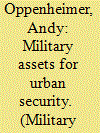

|
|
|
| 18 |
ID:
129100
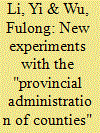

|
|
|
|
|
| Publication |
2014.
|
| Summary/Abstract |
Since 2005. China has witnessed the emergence of a new form of administrative organization. In contrast with the earlier model of "City Jurisdiction Over Counties." which placed counties under the jurisdiction of cities. a new pilot program known as "Provincial Administration of Counties" has been launched. This program places counties and county-level cities under the direct administration of provinces. instead of prefecture-level cities. The central state has played a modest role in implementing this pilot program. whereas provincial and country-level governments have taken a more proactive approach. The central
movement hopes that such a reform can address development imbalances that exist between counties and cities. Meanwhile. provincial governments see the reformats as a way to promote economic develop mint initiatives in counties and county-level cities. However. the implementation of reforms at the local level is not proceeding smoothly. This is mainly due to an asymmetry of power in city-county relations. itself' a legacy of earlier economic reforms that created the City Jurisdiction Over Counties system. This asymmetry has prevented ttrbanruraz tensions from being resolved. lnstead. such tensions have been shifted t'lownward to the city district level or upward to the regional level.
|
|
|
|
|
|
|
|
|
|
|
|
|
|
|
|
| 19 |
ID:
150464
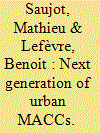

|
|
|
|
|
| Summary/Abstract |
Many cities are implementing policies and climate action plans. Yet local climate policies suffer from a lack of scientific understanding and evaluation methods able to support the definition of efficient mitigation strategies. The purpose of this paper is to build on classical approaches in the energy policy field that exist at the national and international level to propose an urban MACCs methodology able to fulfill this lack and inform local debates. The methodology is an extension of static “expert-based” MACCs; it combines a land use transport integrated model and an abatement cost methodology that integrates co-benefits, and takes into account the spatial and systemic dimensions of cities. The methodology is implemented for the transportation sector of a mid-sized European city (Grenoble, France). Our results present the cost-effectiveness and political feasibility of several proposed measures. We find that the inclusion of co-benefits can profoundly change the cost-benefit assessment of transport mitigation options. Moreover we underline the key parameters determining the cost-effectiveness ranking of mitigation options. These urban MACCs aim to serve as a bridge between urban planning and mitigation policies and can thus contribute to strengthen and align sustainable and climate change agendas at the local level.
|
|
|
|
|
|
|
|
|
|
|
|
|
|
|
|
| 20 |
ID:
153019
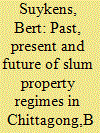

|
|
|
|
|
| Summary/Abstract |
This article argues for the need to take time into account when understanding land ownership in slums. It shows that this allows comprehending more accurately the place of land law and the specific forms that legal struggles over land take. Field research in a slum in Chittagong (in Bangladesh) reveals that while contemporary practices of ownership and transfer might appear to be informal and illegal, they are not only grounded in historical forms of legal land settlement, embedded in a long-standing court battle over legal ownership, but also the product of expectations related to the (legalised) future. Finally, urban planning, with a state-sponsored vision of the future of slums, further complicates the role of the law.
|
|
|
|
|
|
|
|
|
|
|
|
|
|
|
|
|
|
|
|
|